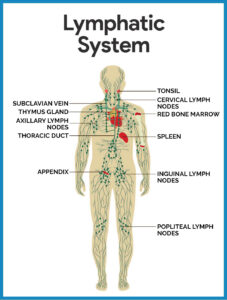CORAL FAQ
You’ve got questions? CORAL has the answers.
What is the Lymphatic System?
 During the initial phases of embryonic development your blood circulation starts to form and grows into a complex circulatory network comprised of 2 systems:
During the initial phases of embryonic development your blood circulation starts to form and grows into a complex circulatory network comprised of 2 systems:
- Closed blood circulation consisting of veins and arteries.
- The half-open lymphatic system which in addition to its known immunological functions, also has important circulatory functions.
Your lymphatic system consists of lymph vessels located just under the skin, meeting up with lymph nodes located in your neck, armpits, and groin. As the lymph vessels move fluid out of the tissues, waste products, bacteria, dead cells, and large protein molecules are collected. The waste products are carried to the lymph nodes to be broken down and eliminated, while the protein rich fluid transported back to the heart to rejoin circulation.
What is Lymphedema?
When the lymph vessels are unable to transport lymph fluid back to circulation it accumulates, resulting in swelling and thickening of the skin. This build up of protein rich lymph fluid is known as Lymphedema. Swelling most commonly occurs in the arms and legs but can also be found in the head, neck, genital area, chest and abdomen. It can affect people of all ages including infants and children. Once the condition occurs swelling will increase if an effective treatment program is not initiated.
At CORAL we understand that while Lymphedema is a distressing and sometimes painful disease which can affect your quality of life we want you to realize that Lymphedema is a treatable condition. Lymphedema is much more common than people realize afflicting approximately 1 percent of the U.S. population (2.5 million Americans), yet its seriousness and the problems it creates are poorly understood by many in the medical community.
How Does Lymphedema Develop?
There are 2 types of Lymphedema: Primary and Secondary.
Primary Lymphedema is caused by a congenital malfunction of the lymphatic system. These malformations are most commonly found in women. They may be present at birth or may develop later, often during puberty or pregnancy. Primary Lymphedema is most common in the legs but may also occur in the arms or torso.
Secondary Lymphedema is a result of damage to the lymphatic system. Surgical procedures such as mastectomy, lumpectomies with radiation, and/or removal of lymph nodes are the most common causes. Secondary Lymphedema is most commonly found in the arms but may also occur in the legs. Other causes may include a traumatic injury infection or severe chronic venous insufficiency.
Symptoms of Secondary Lymphedema may develop immediately after a procedure, sometimes years later or not at all.
Although they are different, both types of Lymphedema progress through the same stages.
Stage 0 (latent stage) – in this early stage of Lymphedema there is no obvious swelling. The lymphatic system, however has been compromised. Symptoms may include a tightness or heaviness or sometimes pain in the affected area.
Stage 1 (reversible stage) – when the affected area is unable to keep up with fluid circulation, swelling of protein rich fluid occurs. Immediate treatment is recommended when swelling is soft and easily managed. With proper treatment, the affected area can be returned to its original size.
Stage 2 (spontaneously irreversible stage) – in this stage swelling of the affected area continues to increase while the texture of the skin changes due to the gradual hardening of tissues known as fibrosis. Risk of infection increases.
Stage 3 (advanced stage) – in this most advanced stage the swelling is severe, skin becomes harder and large bulges may develop. There is also a much greater risk of life threatening infection in the affected area.
Early detection and diagnosis of Lymphedema by your doctor is essential. Lymphedema should be treated as early as possible in order to prevent complications, such as infections, fibrosis and increased swelling. It is important to remember that treatment is still effective at later stages, although a longer period of treatment will be required to reduce swelling and to breakdown fibrosis.
What can be done to help? If your doctor has diagnosed you with Lymphedema you should be referred to a fully trained and certified Lymphedema therapist. At CORAL the treatment you will receive includes complex decongestive therapy (CDT). CDT is regarded as the treatment of first choice in the management of Lymphedema and consists of 2 Phases:
Phase I – The Intensive Phase
This phase aims to reduce swelling as much as possible, initiating the breakdown any fibrotic tissue which may have developed. CORAL will also teach you the skills to manage the condition yourself.
Phase II – The Maintenance Phase
This phase is long term and aims to maintain and further improve the outcomes of Phase I. In most cases, patients can lead virtually normal lives by following the treatment guidelines.
Research has shown that other treatments such as diuretics and/or surgery are inappropriate and have not proven successful for treating Lymphedema.
